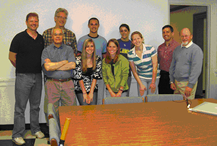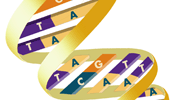- Introduction
- Careers
- Undergraduate Research
- Curriculum
- Admissions
- Contacts
- Advisory Board
- Affiliated Faculty
- News

News
Laura Sloofman takes first place in the HHMI summer research symposium. The first place award is sponsored by Sigma Xi, the scientific research society, and includes a $100 cash prize and a year's membership in the honorary society.
Laura Sloofman is a Quantitative Biology major, our newest interdisciplinary program designed in close
collaboration between faculty in Mathematical Sciences, Biological Sciences and
Chemical Engineering, and offered by the Department of Mathematical Sciences in
collaboration with the Department of Biological Sciences.
M260

Back row, left to right: Dr. Pelesko, Dr. White, Pete Ucciferro, Amanda Brophy and Dr. Rossi; Front row, left to right: Dr. Schleiniger, Meghan McCabe, Kelly Pippins, Zari Johnson and Dr. Usher Not in the picture: Dr. Dhurjati
Our new Bachelor of Science degree program in Quantitative Biology has seen its first crop of majors complete the first course designed specifically for the new program. In the Spring 2008 semester, students in MATH260, our new integrative seminar in quantitative biology, spent the semester studying the problem of domain formation in cell membranes. Led by Professor John A. Pelesko, Department of Mathematical Sciences, this group of five students began the semester by identifying a problem of biological interest and reading the primary literature in the field. They then extracted aspects of the problem that were amenable to mathematical analysis and spent the remainder of the semester developing a mathematical model of domain formation. On May 16, the class presented the results of their work to a subset of the group of faculty involved in designing the new major. Present were Professors Prasad Dhurjati, Gilberto Schleiniger, Louis Rossi, David Usher, and Harold White. The final presentation as well as additional information on the project may be found on the course wiki: http://mathmodelingfall2007.pbwiki.com/Math+260
MATH 260 – A Testimonial by Peter Ucciferro
MATH 260 was an excellent learning experience. The major QBIO mostly consists of classes that are typically math or biology or chemistry. In class there isn’t much of an overlap of these fields, and often times it is difficult to make connections from one subject to the other. MATH 260 was the first class where understanding the biology was just as important as the mathematics. It stressed important abilities such as reading and understanding scientific papers, the importance of programming/computer computation, and most importantly the link between mathematics and life science.
Last semester in MATH 260 our project was very interesting. We spent the entire semester attempting to mathematically model domain formation within artificial lipid membranes. Using the Ising Model as a starting point, we tried “fine tuning” and adjusting this concept to better explain the true activity of what was being observed in laboratory experiments. Although we did not make any Nobel Prize winning discoveries, we did gain experience in what it is like trying to solve problems and explain ideas that have not been solved before. We were particularly interested in this problem because the presence of micro-domains in living cells is still being disputed today. Many scientists feel that these micro-domains (or lipid rafts) may play an important role in not only cell signaling but also protein function within the cell membrane. Extensions of our work may hopefully help to answer questions like why and how are these domains forming.
